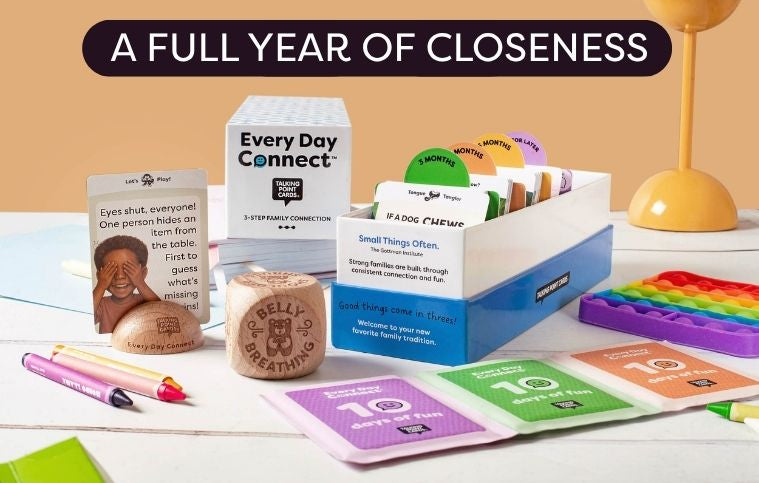SHOP
About

Can Family Conversation Cards Engage My Family?
December 02, 2023 4 min read
Family conversation starter cards are a simple, yet effective tool designed to spark interesting and meaningful discussions within a family. These cards typically feature a variety of questions, prompts, or topics meant to inspire conversation, foster connection, and deepen relationships among family members.
With its simple rules, the conversation cards offer a relaxed and intimate way of gaining a deeper connection within your family. In this post, you can explore the entertainment and light-hearted fun the family conversation cards game offers in its questions relating to a broad range of engaging and entertaining topics.

How Family Conversation Cards Work
The family conversation cards bond your family by displaying each person’s unique character in the form of entertaining, light-hearted questions. These conversation cards can bring your family together by discovering playful, engaging facts about each other with the additional bonus of opening up further group conversation on the topic. Every family member can relate to the questions given, making the game available, inclusive, and understandable for nearly every age group to participate in.
Here’s how it works:
- Diverse topics: These cards cover a broad range of topics, from lighthearted and fun to more thought-provoking and reflective. They may include questions about family traditions, personal experiences, future goals, or hypothetical scenarios.
- Question format: Each card usually contains a single question or prompt. The idea is for one family member to draw a card and pose the question to the group, initiating a conversation.
- Random selection: The random selection of cards adds an element of surprise to the conversations, making them more engaging and preventing discussions from becoming predictable.
- Rotation or pass-and-play: Depending on the dynamics of your family, you can have each member take turns drawing and asking questions, or you can pass the cards around for everyone to participate.
- Encourages active listening: The nature of the questions often encourages active listening and thoughtful responses, fostering a deeper understanding of each family member's thoughts and perspectives.
How to Engage Everyone with Family Conversation Questions
Engaging a mix of ages, especially with teens and primary-age kids, may feel like a challenge, especially if some family members are already reluctant to join family conversations. So here are some strategies to encourage participation and create an inclusive environment for family conversation cards:
- Choose inclusive subjects: Select conversation starter cards or topics that are broad and inclusive, appealing to both teens and younger children. Topics related to shared family experiences, dreams, or even hypothetical scenarios can capture the interest of a diverse age group.
- Rotate the role of question poser: Allow each family member, regardless of age, to take turns posing questions. This empowers everyone to contribute and ensures that each person has a chance to engage in the conversation.
- Mix lighthearted and serious questions: Balance the questions with a mix of lighthearted, fun topics and more serious or thought-provoking ones. This variety keeps everyone interested and accommodates different preferences within the family.
- Create a judgment-free zone: Establish a safe and judgment-free environment where all family members feel comfortable sharing their thoughts. This is especially important for teens who may be more reserved.
- Adapt the format: Consider adapting the format based on the dynamics of your family. Some families may prefer a more structured approach, while others might enjoy a more casual, pass-and-play format. Be flexible and open to what works best for your family.
- Use visual aids: For younger children, consider incorporating visual aids or props that correspond to the topics. This adds a multisensory element to the conversation and can make it more engaging for primary-age kids.
- Encourage storytelling: Encourage family members to share stories related to the topic. This can be especially appealing to teens, who may enjoy reminiscing about shared experiences and contributing their perspectives.
- Be mindful of attention spans: Recognize that attention spans vary across age groups. Keep discussions lively, and consider breaking longer sessions into shorter, focused segments to maintain engagement.
- Celebrate differences: Embrace and celebrate the diverse interests, perspectives, and experiences within your family. This acknowledgment can foster a sense of inclusivity and encourage participation.
- Respect individual preferences: Recognize that individuals may have different communication styles. Some may prefer verbal expression, while others may enjoy drawing, writing, or using other creative outlets to participate.
- Use ice-breaker games: Incorporate ice-breaker games or activities that get everyone involved. Games add an element of fun and can help ease any initial hesitations about participation.
- Lead by example: Parents and older siblings can lead by example. Sharing personal stories and actively participating in discussions can encourage younger family members to do the same.
By creating a positive and inclusive atmosphere, respecting individual preferences, and tailoring the approach to accommodate a mix of ages, you can encourage active participation and create enjoyable and meaningful family conversations.

Benefits of Family Dinner Conversation Starters
Every player can contribute to an answer by chiming in with their own personal experiences and stories while playing this fun, family-oriented game. Enjoy memorable conversations with family and connect in lively, light-hearted family moments while enjoying the following benefits:
- Quality family time: Using these cards creates intentional time for family members to connect and communicate, fostering a sense of togetherness and strengthening family bonds.
- Breaks routine: They provide a break from routine conversations and allow family members to discuss topics they might not typically explore during day-to-day interactions.
- Encourages sharing: By posing open-ended questions, these cards encourage family members to share more about their thoughts, experiences, and feelings, leading to more meaningful conversations.
- Enhances communication skills: Family conversation starter cards can contribute to the development of good communication skills, including active listening, expressing oneself, and respectful dialogue.
- Creates lasting memories: Engaging in memorable conversations facilitated by these cards can create lasting memories. These shared experiences contribute to a positive family culture.
- Adaptable for all ages: Many sets of conversation starter cards are designed to be adaptable for various age groups, ensuring that they can be enjoyed by both younger and older family members.
- Portable and convenient: Conversation starter cards are often compact and portable, making them easy to bring along for family outings, vacations, or any time you want to engage in meaningful discussions.
Whether you're gathered around the dinner table, during a family game night, or while spending quality time together, family conversation cards from Talking Point Cards provide an interactive and enjoyable way to strengthen familial connections. They are a valuable tool for creating a positive and communicative family environment.






